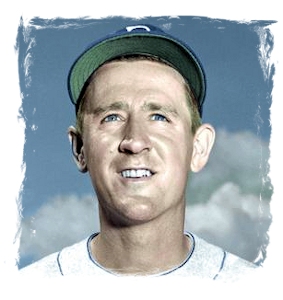 |
Johnny Schmitz was born in Wausau, Wisconsin, on November 27, 1920. He attended the Wausau schools up through ninth grade, and was something of a star in American Legion baseball. In 1937 he achieved the rare feat of striking out four batters in one inning. Johnny was signed originally before the 1938 season by the Milwaukee Brewers of the American Association, a team that had a working agreement with the Cleveland Indians. Only 17 at the time, he was placed with the Hopkinsville (Kentucky) Hoppers of the Class-D Kitty League. The working agreement with the Indians expired, and his contract was assumed by the Chicago Cubs prior to the 1939 season. He spent most of 1939 playing with the Bloomington (Illinois) Bloomers in the Class-B Three-I League and also pitched in two games for the Double-A Brewers, and lost them both. His 1940 season was spent playing for the Three-I Leagueís Madison Blues, in Wisconsin. He had a very good 3.28 earned-run average. In 1941 Schmitz he got a taste of the big leagues at the end of the season. It hadnít been a strong season for him, working in Double A for the Brewers, and was called up to the Cubs at the end of the season. His major-league debut came in Pittsburgh on September 6th. In 1942, the Cubs finished in sixth place, 38 games out of first. Johnny had 10 starts and worked in 13 games as a reliever. It was his last pro season for the duration of the war, because immediately after the game, he reported for induction. He served in the Navy from August 3, 1942, until early January 1946, when he was released in time to join the Cubs for spring training on Catalina Island. He did pitch in the Navy, at the vaunted Great Lakes Naval Training Center team, before being sent to the Pacific as a specialist 3rd class in the athletic department. He had little opportunity to play baseball while on duty in the Pacific, however. Pitching for the 1946 Cubs, Johnny was given 31 starts and became an All-Star. His record for the year was 11-11, but his 2.61 earned-run average was a strong one. He had a good 3.22 ERA in 1947, ranking 10th-best in the National League, but wound up leading the league in losses with 18. He flipped the won-lost record to 18-13 in 1948, and was again an All-Star. He finished 12th in MVP voting with an ERA of 2.64. The 1949 Cubs finished in last place and with 11 victories, was the winningest pitcher on the team. The Cubs nudged up one rung on the ladder in 1950, to seventh place, but Johnny declined in effectiveness. Before December was out, there was talk of a trade between the Cubs and Dodgers, but nothing came of it until the trading deadline in June, 1951. The trade in June was an eight-player deal, with Andy Pafko being the big name leaving the Cubs.He didnít get much better and was 1-4, with a 5.34 earned-run average for the Dodgers. No longer able to throw with the same sort of blazing speed he had had before taxing his arm too much in 1949, he made some adjustments. But at the end of July in 1952, though, he had a 4.32 ERA and had appeared in only 10 games He was placed on waivers, and none of the National League teams bit, but the New York Yankees paid the $10,000 waiver price, and Johnny left Brooklyn for the Bronx. In August, he was sent back to the National League, part of a deal in which the Yankees sent four players and $35,000 to the Cincinnati Reds to get pitcher Ewell Blackwell. Then Johnny was brought back to the Yankees, purchased from the Reds in February, 1953 This stay with the Yankees was even briefer. He worked a total of 4 1/3 innings in three appearances, before being claimed off waivers by the Washington Senators in May. He found a new home, at least for a couple of years. He pitched reasonably well the remainder of 1953, with a 3.68 ERA. In 1954 he had a very good year and worked as a regular, starting 23 games and pitching to an ERA of 2.91. He was back with them again for a second full season in 1955. He didnít have a winning record, but Washington was a last-place team, but his ERA was a solid 3.71. In November, he was in another multiplayer trade, this one sending him to the Boston Red Sox with Bob Porterfield, Tom Umphlett and Mickey Vernon. in 1956, he was hampered by a foot infection during spring training. He got into a couple of games for the Red Sox in relief, throwing 4 1/3 innings. In May, he was purchased by the Baltimore Orioles. Heworked the rest of the season for the Orioles and in October, was released. His big-league career was over. He finished with a lifetime mark of 93-114 with a good 3.55 earned-run average. He gave it one more year, pitching in the Triple-A International League for the Toronto Maple Leafs. Later that year, he left the game of baseball and began work as a greenskeeper at Wausau American Legion Golf Course. In 1958, he pitched for the Wausau Bakers in the semipro Wisconsin Valley League. He also enjoyed spending time in northern Wisconsin hunting and ice-fishing, along with woodworking at his home. Johnny Schmitz entered hospice care and was at the Asera Care Hospice at Rib Mountain, Wisconsin, where he died on October 1, 2011 at age 90. |
|||||
